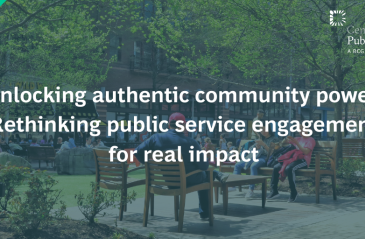
The power of storytelling in climate leadership

Cities big and small, urban and rural, are bridging the digital divide through new and creative means. #FutureofCities
Share article.@CPI_Foundation, @BCG and @AspenUrbanInnov are sharing how city problem-solvers are innovating with intention to achieve impact
Share article@Josh_Sorin explores how cities are bridging the digital divide in the era of ‘smart cities’ #FutureofCities
Share articleWe put our vision for government into practice through learning partner projects that align with our values and help reimagine government so that it works for everyone.
In the early to mid-twentieth century, decades after electric power had already become an inextricable part of urban life in the United States, 90% of Americans living in the countryside found themselves on the wrong side of an electric divide - denied access to electricity by the powerful utility companies. There's a brilliant chapter in the first volume of Robert Caro's biography of President Lyndon Baines Johnson, where Caro captures the consequences suffered by the residents of LBJ's hometown (the “Hill Country”) who were denied access to electricity.
“because there was no electricity, moreover, a Hill Country farmer could not use an electric pump. He was forced not only to milk but to water his cows by hand, a chore that, in dry weather, meant hauling up endless buckets from a deep well. Because he could not use an electric auger, he had to feed his livestock by hand... because he could not use an electric grinder, he would get the corn kernels for his mules and horses by sticking ears of corn-hundreds of ears of corn-one by one into a corn sheller and cranking it for hours. Because he could not use electric motors, he had to unload cotton seed by hand, and then shovel it into the barn by hand; to saw wood by hand, by swinging an axe or riding one end of a ripsaw.”
In 1936, the federal government, urged on by congressmen from rural congressional districts like LBJ, took sweeping steps to bring electricity to rural America by creating the Rural Electrification Administration. In the ensuing years, the electric divide was effectively closed, with 96% of farmers receiving access to electricity within 20 years.
As the pace of technology has accelerated, a new digital divide has opened up in American society, disproportionately affecting low-income communities and the elderly population. Much like the electric divide, the digital divide deprives affected communities of access to basic services that most of us take for granted, resulting in lower rates of employment and educational outcomes. A child whose family doesn't have access to the internet can't do her homework and falls behind in school. An elderly grandmother who doesn't own (or doesn't know how to use) an iPhone can't book an Uber, limiting her ability to see a doctor. And a working mom can't find a better job when the application she has to complete is online.
The digital divide is not only a problem for affected communities, but also for cities as a whole. Residents that lack digital access and literacy cannot compete in the digital economy, hampering the economic growth of cities as their workforces lack the skills necessary for the jobs of the future. And the growing digital divide undermines the legitimacy of local government as low income and elderly residents are left behind and shut out from educational and economic opportunities.
Two key differences exist between electric and digital divides. First, where the electric divide was primarily rural versus urban, the digital divide exists not only between rural and urban areas, but also within urban areas where access to digital technologies can differ between communities that live next to each other. Second, where solving the electric divide required sweeping action by Congress through the creation of the Rural Electrification Administration, cities are not waiting on the federal government to take action.
Cities big and small, urban and rural, are bridging the digital divide through new and creative means. These cities possess a keen understanding that in order for the city to become ‘smart' it must also become inclusive.
In San José, the City created a $24 million Digital Inclusion Fund (DIF), financed by access fees paid by telecommunication companies, with the goal of bringing broadband connectivity and digital skills to 50,000 households over the course of the next decade. In Arlington, VA, the City is piloting a digital inclusion initiative by providing free broadband Internet access to low-and-moderate-income households. And the city of Philadelphia, following the example set by New York City, is installing free, wi-fi kiosks on the city's streets.
At a time when the federal government is mired in partisan gridlock, the efforts by these cities and others are indicative of a larger trend. Across the country, a diverse group of unheralded city problem-solvers are using new technologies, innovation, and cross-sector coalitions to tackle problems and create more livable, equitable, and resilient cities.
***
Over the last few months, the Centre for Public Impact, in partnership with the Center for Urban Innovation at The Aspen Institute and the Boston Consulting Group, has spoken to these problem-solvers in American cities to understand how they are innovating to drive change for residents on the biggest challenges. Our findings are detailed in The Future of Cities handbook. To find out more and to join the conversation, visit our website.
The Future of U.S. Cities: We spoke to over 40 city-problem solvers to explore how cities are innovating to drive impact
Building a culture of innovation in a small city - interview with Jessica Kahlenberg. Being the first and only person in her city's innovation team isn't stopping Jessica Kahlenberg from making impact.
12 Top Tips: Driving impact and innovation in North American cities
Houston, lift off. Houston's Mayor, Annise Parker, oversees America's fourth largest city, one with a booming population and jobs market. But she's not about to take her foot off the gas
Wired up and fired up. Few cities have embraced the digital revolution as successfully as Kansas City. Its mayor, SlyJames, tells us how technology is transforming public services and opening up new opportunities for his community today - and tomorro
Sizing up San Diego. San Diego is on the move. Its mayor, Kevin Faulconer, tells Danny Acosta about the challenges of leading California's second largest city into a prosperous future
#FutureofCities












